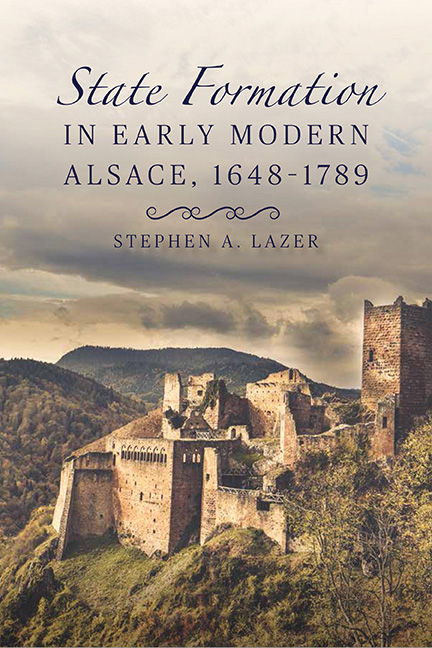Book contents
Summary
Alsace is one of Europe's most historically significant borderlands. Like most borderlands, it has always been a zone of contradictions, simultaneously dividing and uniting peoples. As a European crossroad, its major cities, especially Strasbourg, offered staging points for the spread of people, goods, information, and ideas. Curiously, considering Alsace's historical importance and geographical centrality, histories of post-Westphalian Alsace have not really addressed its character as a borderland, although they have acknowledged the significance of its position on the French periphery. The common perspective of a French center busily constructing the state in its new, peripheral province in Alsace, while historically valuable, ignores the Holy Roman Empire's enormous and continued influence on Alsatian political culture. Alsatians, furthermore, did not consider themselves peripheral. Investigating post-Westphalian Alsace as a borderland allows us to sever the center-periphery dichotomy and enables a more thorough understanding of how multiple and competing pressures shaped early modern Alsatians and their political culture. This book uses an examination of the territories that the dynasty of Pfalz-Zweibrücken-Birkenfeld ruled in post-Westphalian Alsace to offer an in-depth analysis of the multiplicity of forces that worked on, and in, Alsace. It probes in considerable detail the context of the dynasty's and thus their territories’ relationship to France as well as its continuing ties to the Holy Roman Empire.
In order to avoid the traditional center-periphery dichotomy and center the position of Alsace as a borderland between France and the empire, this book adopts an Alsatian perspective in exploring the development and operation of the French state. It reconstructs how the French monarchy negotiated a contingent sovereignty over Alsace's many autonomous polities to transform a fractured borderland into something resembling a province, albeit one that maintained more than its fair share of peculiarities that remain so evident even today. The monarchy, eager to piggyback on the legitimacy of the pre-existing elites, readily compromised with Alsatian authorities, leaving them with much of the autonomy they had enjoyed as part of the empire, creating a series of what may be usefully termed “two-centered” states.
- Type
- Chapter
- Information
- State Formation in Early Modern Alsace, 1648–1789 , pp. 1 - 12Publisher: Boydell & BrewerPrint publication year: 2019

